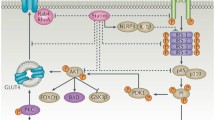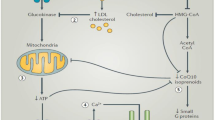Abstract
Purpose of Review
This review summarizes the recent population-based studies, clinical trials, clinical metabolic studies, and genetic studies reporting the effects of statin therapy on the risk of diabetes. Recent studies aiming to explain the mechanisms how statin treatment affects insulin sensitivity and insulin secretion are also reviewed.
Recent Findings
Statin therapy increases the risk of diabetes by 9%–12% in the two meta-analyses of statin trials and by 18%–99% in five population-based studies. Statin therapy impairs insulin sensitivity and insulin secretion based on clinical and epidemiologic studies. In vitro studies demonstrate that the most diabetogenic statins impair insulin sensitivity and insulin secretion by multiple mechanisms. Recent genetic studies suggest that the increased risk of type 2 diabetes may be partially explained by gene variants in the target genes for low-density lipoprotein cholesterol lowering drugs.
Summary
Population-based studies report higher incidence rates for diabetes in individuals on statin treatment compared with clinical trials. Incident diabetes has not been a prespecified endpoint in statin trials and glucose and/or HbA1c have not been routinely measured. Therefore, it is possible that the risk of diabetes in individuals on statin treatment has been underestimated in previous statin trials. Accumulating evidence from several statin trials, population-based studies, clinical studies, and in vitro studies suggests that pravastatin is the least diabetogenic statin, and simvastatin, atorvastatin, and rosuvastatin the most diabetogenic statins. In vitro studies have reported new findings on mechanisms how statin treatment affects insulin sensitivity and insulin secretion. In spite of diabetogenicity of different statins, the consensus is that the benefits of statins in reducing cardiovascular events clearly outweigh the risk of diabetes.



Similar content being viewed by others
References
Papers of particular interest, published recently, have been highlighted as: • Of importance •• Of major importance
Tobert JA. New developments in lipid-lowering therapy: the role of inhibitors of hydroxymethylglutaryl-coenzyme A reductase. Circulation. 1987;76:534–8.
•• Collins R, Reith C, Emberson J, Armitage J, Baigent C, Blackwell L, et al. Interpretation of the evidence for the efficacy and safety of statin therapy. Lancet. 2016. An extensive and updated review on the evidence for the efficacy and safety of statin therapy.
Freeman DJ, Norrie J, Sattar N, et al. Pravastatin and the development of diabetes mellitus: evidence for a protective treatment effect in the West of Scotland Coronary Prevention Study. Circulation. 2001;103:357–62.
Betteridge DJ, Carmena R. The diabetogenic action of statins—mechanisms and clinical implications. Nat Rew Endocrinol. 2016;12:99–110.
Culver AL, Ockene IS, Balasubramanian R, et al. Statin use and risk of diabetes mellitus in postmenopausal women in the Women’s Health Initiative. Arch Intern Med. 2012;172:144–52.
Zaharan NL, Williams D, Bennett K. Statins and risk of treated incident diabetes in a primary care population. Br J Clin Pharmacol. 2013;75:1118–24.
Macedo AF, Douglas I, Smeeth L, Forbes H, Ebrahim S. Statins and the risk of type 2 diabetes mellitus: cohort study using the UK clinical practice pesearch datalink. BMC Cardiovasc Disord. 2014;14:85.
Cederberg H, Stančáková A, Yaluri N, Modi S, Kuusisto J, Laakso M. Increased risk of diabetes with statin treatment is associated with impaired insulin sensitivity and insulin secretion: a 6 year follow-up study of the METSIM cohort. Diabetologia. 2015;58:1109–17.
Rha SW, Choi BG, Seo HS, et al. Impact of statin use on development of new-onset diabetes mellitus in Asian population. Am J Cardiol. 2016;117:382–7.
Ridker PM, Danielson E, Fonseca FA, et al. Rosuvastatin to prevent vascular events in men and women with elevated C-reactive protein. N Engl J Med. 2008;359:2195–207.
Kjekshus J, Apetrei E, Barrios V, et al. Rosuvastatin in older patients with systolic heart failure. N Engl J Med. 2007;357:2248–61.
Tavazzi L, Maggioni AP, Marchioli R, et al. Effect of rosuvastatin in patients with chronic heart failure (the GISSI-HF trial): a randomised, double-blind, placebo-controlled trial. Lancet. 2008;372:1231–9.
• Sattar N, Preiss D, Murray HM, et al. Statins and risk of incident diabetes: a collaborative meta-analysis of randomised statin trials. Lancet. 2010;375:735–42. The first meta-analysis to demonstrate that statin treatments is associated with the risk of diabetes.
Preiss D, Seshasai SR, Welsh P, et al. Risk of incident diabetes with intensive-dose compared with moderate-dose statin therapy: a meta-analysis. JAMA. 2011;305:2556–64.
Navarese EP, Buffon A, Andreotti F, et al. Meta-analysis of impact of different types and doses of statins on new-onset diabetes mellitus. Am J Cardiol. 2013;111:1123–30.
•• Swerdlow DI, Preiss D, Kuchenbaecker KB, et al. HMG-coenzyme A reductase inhibition, type 2 diabetes, and bodyweight: evidence from genetic analysis and randomised trials. Lancet. 2015;385:351–61. The first study to show that the increased risk of type 2 diabetes associated with statins is at least partially explained by HMGCR inhibition.
•• Lotta LA, Sharp SJ, Burgess S, et al. Association between low-density lipoprotein cholesterol-lowering genetic variants and risk of type 2 diabetes: a meta-analysis. JAMA. 2016;316:1383–91. This meta-analysis shows that LDL-C-lowering genetic variants in or near NPC1L1 and PCSK9 genes were associated with a higher risk of type 2 diabetes. These data provide insights into potential adverse effects of LDL-C-lowering therapy.
• Besseling J, Kastelein JJ, Defesche JC, Hutten BA, Hovingh GK. Association between familial hypercholesterolemia and prevalence of type 2 diabetes mellitus. JAMA. 2015;313:1029–36. This study showed that the prevalence of type 2 diabetes among patients with familial hypercholesterolemia was significantly lower than among unaffected relatives.
Baker WL, Talati R, White CM, Coleman CI. Differing effect of statins on insulin sensitivity in nondiabetics: a systematic review and meta-analysis. Diabetes Res Clin Pract. 2010;87:98–107.
Puurunen J, Piltonen T, Puukka K, et al. Statin therapy worsens insulin sensitivity in women with polycystic ovary syndrome (PCOS): a prospective, randomized, double-blind, placebo-controlled study. J Clin Endocrinol Metab. 2013;98:4798–807.
Moutzouri E, Liberopoulos E, Mikhailidis DP, et al. Comparison of the effects of simvastatin vs. rosuvastatin vs. simvastatin/ezetimibe on parameters of insulin resistance. Int J Clin Pract. 2011;65:1141–8.
Paniagua JA, López-Miranda J, Escribano A, et al. Cerivastatin improves insulin sensitivity and insulin secretion in early-state obese type 2 diabetes. Diabetes. 2002;51:2596–603.
Yaluri N, Modi S, Kokkola T. Simvastatin induces insulin resistance in L6 skeletal muscle myotubes by suppressing insulin signaling, GLUT4 expression and GSK-3β phosphorylation. Biochem Biophys Res Commun. 2016. doi:10.1016/j.bbrc.2016.10.026.
Kain V, Kapadia B, Misra P, Saxena U. Simvastatin may induce insulin resistance through a novel fatty acid mediated cholesterol independent mechanism. Sci Rep. 2015;5:13823. doi:10.1038/srep13823.
Henriksbo BD, Lau TC, Cavallari JF, et al. Fluvastatin causes NLRP3 inflammasome-mediated adipose insulin resistance. Diabetes. 2014;63:3742–7.
Ashcroft FM, Rorsman P. Diabetes mellitus and the β cell: the last ten years. Cell. 2012;148:1160–71.
Yaluri N, Modi S, López Rodríguez M, et al. Simvastatin impairs insulin secretion by multiple mechanisms in MIN6 cells. PLoS One. 2015;10, e0142902.
Yada T, Nakata M, Shiraishi T, Kakei M. Inhibition by simvastatin, but not pravastatin, of glucose-induced cytosolic Ca2+ signalling and insulin secretion due to blockade of L-type Ca2+ channels in rat islet beta-cells. Br J Pharmacol. 1999;126:1205–13.
Zhou J, Li W, Xie Q, et al. Effects of simvastatin on glucose metabolism in mouse MIN6 cells. J Diabetes Res. 2014;2014:376570.
Ishikawa M, Okajima F, Inoue N, et al. Distinct effects of pravastatin, atorvastatin, and simvastatin on insulin secretion from a beta-cell line, MIN6 cells. J Atheroscler Thromb. 2006;13:329–35.
Zhao W, Zhao SP. Different effects of statins on induction of diabetes mellitus: an experimental study. Drug Des Devel Ther. 2015;9:6211–23.
Lorza-Gil E, Salerno AG, Wanschel AC, et al. Chronic use of pravastatin reduces insulin exocytosis and increases β-cell death in hypercholesterolemic mice. Toxicology. 2016;17(344-346):42–52.
Abe M, Toyohara T, Ishii A, et al. Drug Metab Pharmacokinet. 2010;25:274–82.
Salunkhe VA, Mollet IG, Ofori JK, et al. Dual Effect of Rosuvastatin on glucose homeostasis through improved insulin sensitivity and reduced insulin secretion. EBioMedicine. 2016;10:185–94.
Salunkhe VA, Elvstam O, Eliasson L, Wendt A. Rosuvastatin treatment affects both basal and glucose-induced insulin secretion in INS-1 832/13 Cells. PLoS One. 2016;11, e0151592.
Mabuchi H, Higashikata T, Kawashiri M, et al. Reduction of serum ubiquinol-10 and ubiquinone-10 levels by atorvastatin in hypercholesterolemic patients. J Atheroscler Thromb. 2005;12:111–9.
McCarty M. Can correction of sub-optimal coenzyme Q status improve beta-cell function in type II diabetics? Med Hypotheses. 1999;52:397–400.
Hao M, Head WS, Gunawardana SC, Hasty AH, Piston DW. Direct effect of cholesterol on insulin secretion: a novel mechanism for pancreatic beta-cell dysfunction. Diabetes. 2007;56:2328–38.
Fizelova M, Miilunpohja M, Kangas AJ, et al. Associations of multiple lipoprotein and apolipoprotein measures with worsening of glycemia and incident type 2 diabetes in 6607 non-diabetic Finnish men. Atherosclerosis. 2015;240:272–7.
Laakso M, Kuusisto J. Insulin resistance and hyperglycaemia in cardiovascular disease development. Nat Rev Endocrinol. 2014;10:293–302.
Nielsen SF, Nordestgaard BG. Statin use before diabetes diagnosis and risk of microvascular disease: a nationwide nested matched study. Lancet Diabetes Endocrinol. 2014;2:894–900.
Author information
Authors and Affiliations
Corresponding author
Ethics declarations
Conflict of Interest
Markku Laakso and Johanna Kuusisto declare that they have no conflict of interest.
Human and Animal Rights and Informed Consent
This article does not contain any studies with animals performed by the authors. All human studies referrer to and performed by the authors have been accepted by the local Ethics Committees.
Additional information
This article is part of the Topical Collection on Other Forms of Diabetes and Its Complications
Rights and permissions
About this article
Cite this article
Laakso, M., Kuusisto, J. Diabetes Secondary to Treatment with Statins. Curr Diab Rep 17, 10 (2017). https://doi.org/10.1007/s11892-017-0837-8
Published:
DOI: https://doi.org/10.1007/s11892-017-0837-8




